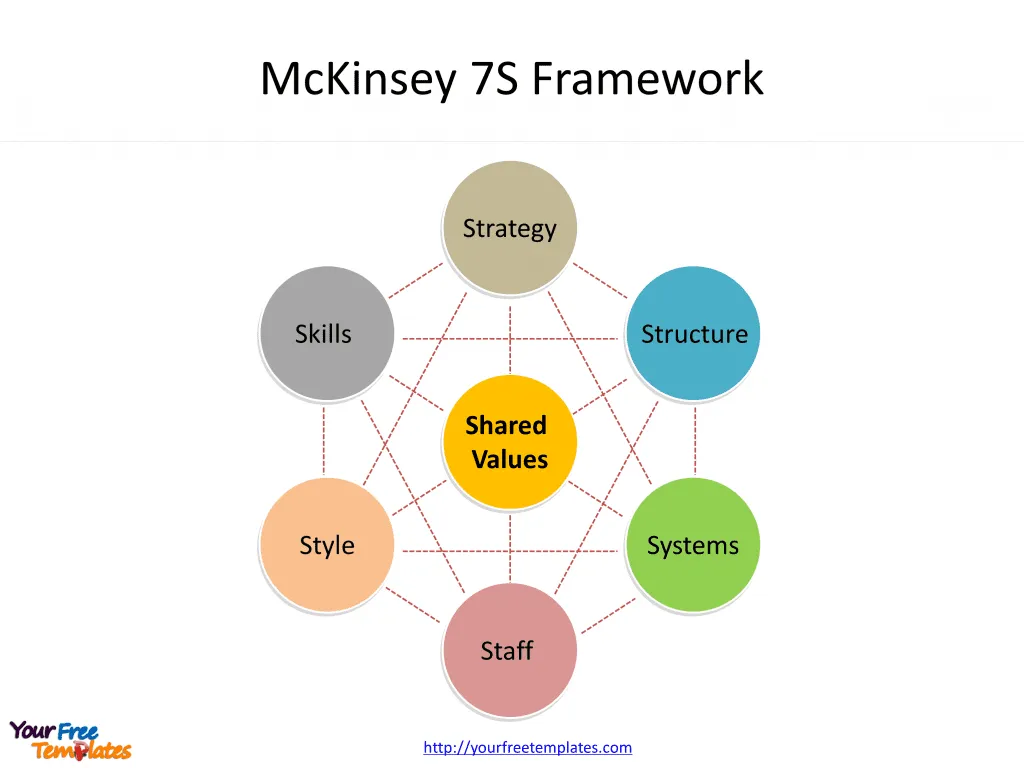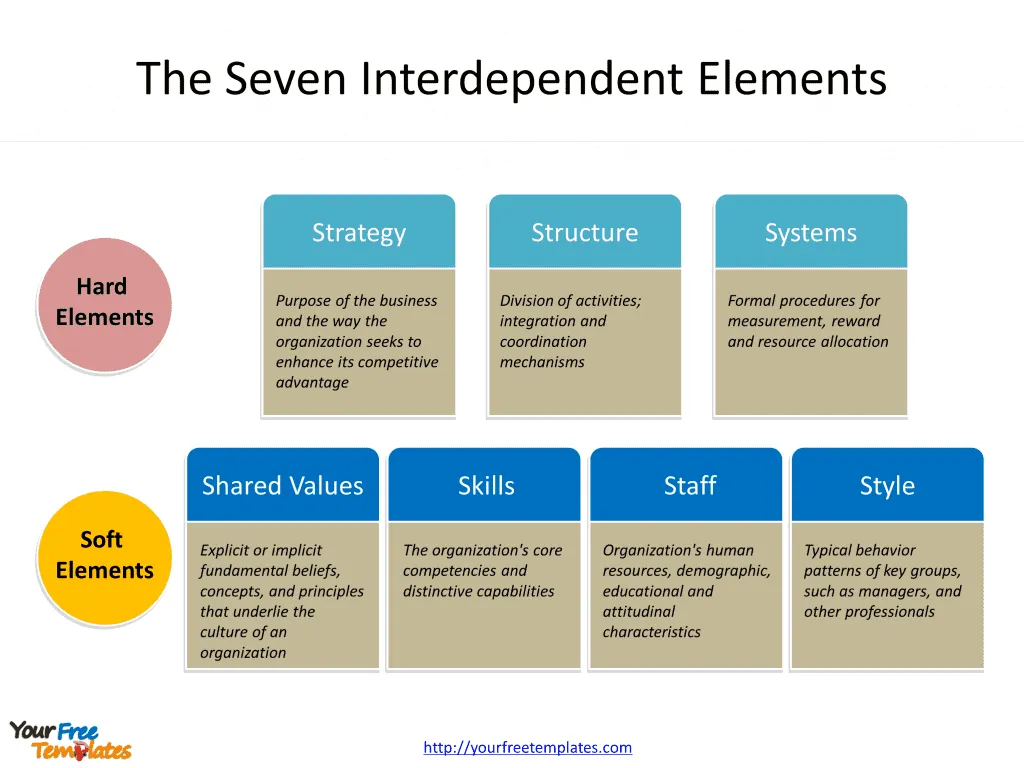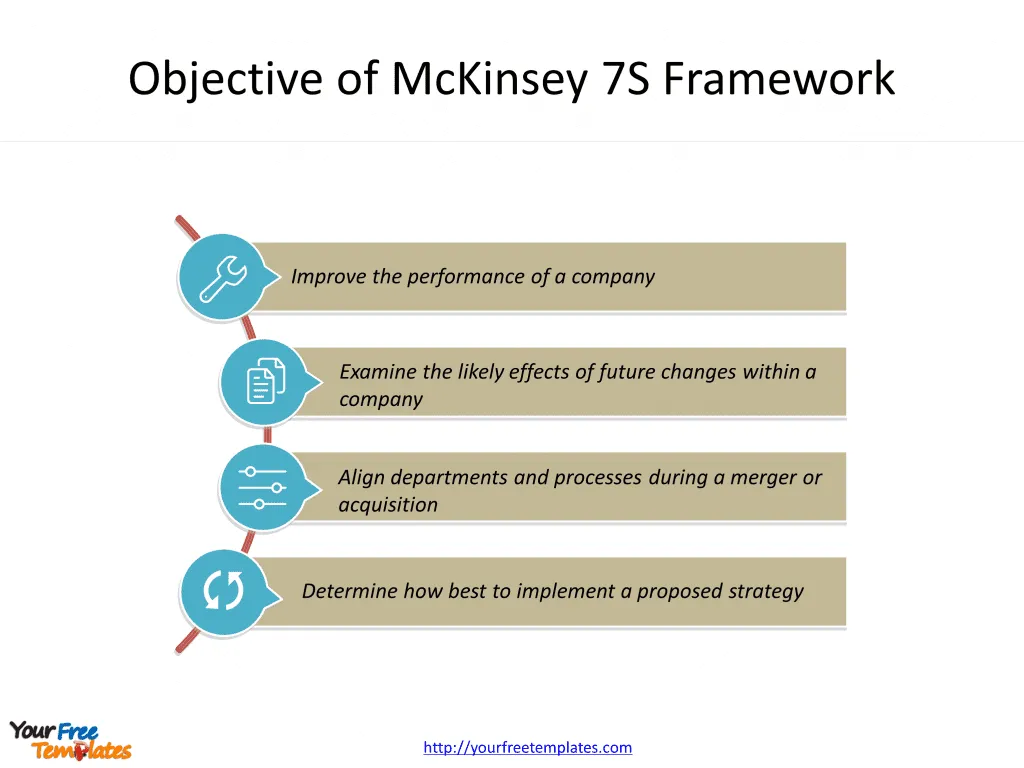The McKinsey 7S Framework Template in PowerPoint format includes three slides. Firstly we have the McKinsey 7S Framework diagram. Secondly we present McKinsey-7S-Framework in hard or soft effects. In the end it is the objectives of McKinsey 7S Framework. As the same diagram PowerPoint template series, you can also find our Marketing mix, Social media marketing, Maslow’s hierarchy of needs, SWOT Analysis, Venn diagram, Data Mining, Machine Learning, cloud computing, Artificial Intelligence and BlockChain PowerPoint templates.
In the realm of strategic planning and organization development, the McKinsey 7S framework reigns supreme as an invaluable tool. This model, devised by the global management consulting firm McKinsey & Company, provides a comprehensive perspective on business operations, enabling companies to achieve their goals more effectively.
Understanding the McKinsey 7S Framework
The McKinsey 7S framework is an organizational tool that evaluates the internal elements of a company, determining its well-being and future success. The model identifies seven internal factors that need to be in harmony for a company to be successful. These factors are classified into “hard” and “soft” elements, the distinction being that hard elements are easily identified and influenced by management, while soft elements are less tangible and influenced by corporate culture.
Slide 1 McKinsey 7S Framework or 7Ss templates.
Origins of the McKinsey 7S Framework
The McKinsey 7S Framework was conceived in the late 1970s by consultants Thomas Peters and Robert Waterman Jr., authors of the management bestseller, “In Search Of Excellence,” while they were at McKinsey & Co. The model was groundbreaking, shifting the focus from organization as structure to the critical role of coordination in organizational effectiveness. This shift marked a watershed moment in thinking about organizational effectiveness.
The Importance of the McKinsey 7S Framework
The McKinsey 7S Framework is beneficial in a variety of situations where understanding the various parts of an organization and how they work together is crucial. It can be used to make decisions on future corporate strategy, assess the likely effects of future changes in the organization, or align departments and processes during a merger or acquisition. Elements of the McKinsey Model 7S can also be applied to individual teams or projects.

Slide 2 McKinsey 7S Framework or the Seven Interdependent Elements.
Hard Elements of the McKinsey 7S Framework
-
Strategy: This refers to the company’s plan of action to ensure competitiveness and success in its industry and market. The strategy should communicate the organization’s objectives and goals clearly and align with the other elements of the model.
-
Structure: This denotes the organization’s hierarchy, chain of command, and divisional composition that illustrates how operations function and interconnect. It elaborates on the management configuration and responsibilities of workers.
-
Systems: This relates to the daily procedures, workflows, and decisions that form the standard operations within the organization.
Soft Elements of the McKinsey 7S Framework
-
Shared Values: These are the commonly accepted standards and norms within the company that influence and shape the behavior of the entire staff and management. These may be detailed in company guidelines and relate to the actual accepted behavior within the workplace.
-
Skills: This encapsulates the talents and capabilities of the staff and management, which determine the types of achievements and work the company can accomplish.
-
Style: This refers to the management’s approach and example in leading the company, as well as how this influences performance, productivity, and corporate culture.
-
Staff: This pertains to the personnel of the company, their motivations, size of the workforce, and how they are trained and prepared to accomplish the tasks set before them.

Slide 3 McKinsey 7S Framework objectives
Applying the McKinsey 7S Framework: A Step-by-step Guide
To apply the McKinsey 7S Framework effectively in an organization, the following steps can be followed:
-
Analyze Each Component: Begin by analyzing each of the seven components of the model, starting with shared values, then moving to the hard elements (strategy, structure, and systems), and finally, the soft elements (skills, staff, and style).
-
Identify Misalignment: Review your findings and identify areas that are not in alignment with your vision and strategy.
-
Define the Desired State: Identify and articulate the organization’s ideal alignment. Review everything and ensure it aligns with your company’s vision and strategy.
-
Prepare a Change Management Plan: Armed with your analysis, prepare a change management plan that clearly defines your strategic objectives, key projects or initiatives, and KPIs.
-
Execute Your Plan: Turn your plans into reality. Getting this step right results in impactful changes and helps your organization reach important milestones.
-
Review Progress: Continually review the performance of your teams and projects to ensure your organization is constantly aligned and on track.
-
Adapt as Needed: Don’t be afraid to change your plans and approach as you progress. Using insights, knowledge, and new information to improve your approach is crucial.

Real-world Application of the McKinsey 7S Framework: Chick-fil-A
To better understand how the McKinsey 7S framework can be applied in a real-world scenario, let’s consider the example of Chick-fil-A, a popular fast-food restaurant chain.
Structure:
Chick-fil-A is a privately-owned fast-food franchise with wholly-owned subsidiaries that supply franchisee restaurants. Individual Chick-fil-A restaurants are owned and operated by franchisees who manage the day-to-day operations in their stores.
Strategy:
Chick-fil-A pursues a market development strategy, expanding into new markets with existing products through franchising. They are also planning to enter new markets, such as Asia.
Systems:
The company operates a franchise and licensing business with a corporate office that manages broad strategic initiatives. It also has a rigorous vetting process for all prospective franchise owners.
Shared values:
Christian and family values play a large part in Chick-fil-A’s corporate identity. Their core values include “We are better together,” “We’re here to serve,” “We are purpose-driven,” and “We pursue what’s next.”
Skills:
The company invests heavily in upskilling franchise owners through training, support, and investments. They also provide staff members with opportunities to grow and move into new roles.
Style:
Chick-fil-A is known for its unique management style and the trust it places in franchise owners. It is known for its servant-leadership style of management.
Staff:
Chick-fil-A represents over 170,000 Team Members, Operators, and Staff who have various roles in the organization.
Conclusion
The McKinsey 7S framework remains a relevant and powerful tool for organizations navigating the complexities of strategic planning and change management. By comprehensively assessing both the tangible and intangible elements of an organization, the framework provides a roadmap for achieving strategic alignment and operational efficiency. Companies that master this framework can better navigate the path to success, ensuring every aspect of their organization is pulling in the same direction.
For detailed info on McKinsey-7S-Framework, please refer to Wikipedia.
Size:78K
Type: PPTX
Aspect Ratio: Standard 4:3
Click the blue button to download it.
Download the 4:3 Template
Aspect Ratio: Widescreen 16:9
Click the green button to download it.
Download the 16:9 Template














